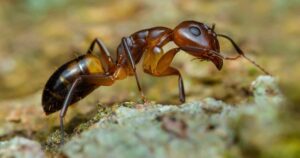Argentine Ant (Linepithema humile)
Updated on
06/02/2023The Argentine ant is a small, omnivorous ant that prefers sweet foods and can infest homes. It is a native of northern Argentina and is a globally distributed pest in natural, urban and agricultural habitats.
Scientific Classification
- Class:Insecta
- Order:Hymenoptera
- Family:Formicidae
- Subfamily:Dolichoderinae
- Genus:Linepithema
- Species:L. humile
Conservation Status
Description
The workers are 0.06-0.11 in (1.6-2.8 mm) long. The queens are of the size 0.17-0.25 in (4.2-6.4 mm). They have a shiny, dark brown to black hairless, smooth body.
Distribution: The invasive species is native to Argentina, Paraguay, Bolivia, Uruguay, and southern Brazil. It has been established in many Mediterranean climate areas, being accidentally introduced by humans to South Africa, Japan, Easter Island, New Zealand, Australia, Hawaii, Europe, and the continental United States, among others.
Habitat: Soil, under logs, wood, mulch, or debris.
Do They Bite/Sting: Yes.
Lifespan: A few days for males, several years for queens, and a few weeks to several months for workers.
Predators: Birds, beetles, flies, caterpillars, spiders, snails, snakes, and lizards.
Behavior and Characteristics
Diet
The ants feed on honeydew, fresh fruits, sweets, oily household foods, and buds of some plants.
Colony Cycle
The workers cannot produce reproductive eggs but can help develop eggs into reproductive females by feeding the young. The amount of food available to the larvae decides the production of the male ants. The colony has many reproductive queens – as many as 8 for every 1000 workers.
Winter is the seasonal low in the number of workers when 90% of the colony comprises of them, the remaining being queens. There is no reproduction and minimal births at that time. Late winter sees the eggs being laid, and almost all hatch into sexual forms by May. Mating occurs when the females emerge. Worker production increases from mid-March to October, replenishing their numbers.
Nest-building
The Argentine ant builds its nest in the ground, in the cracks of concrete walls, spaces between timbers and boards, and even among belongings kept in houses. In natural surroundings, they nest at shallow levels below small stones or in leaf litter. It is because they can’t dig deep down. But if a deeper nesting ant species abandons its nest, Argentine ants will readily take over it.
The absence of aggression within their own colonies have allowed them create super-colonies in most parts of their introduced range. A colony has millions of ants in many sub-colonies.
Life Cycle
1. Egg Stage
As many as 60 white eggs are laid by a queen in a day. The transition between the life cycle stages heavily depends on temperature.
2. Larva Stage
The larvae hatch out of the eggs in 28 days.
3. Pupa Stage
The pupa develops into an adult in 8-25 days, depending on the temperature.
4. Adult Stage
The winged queens don’t undertake mating flights. Instead, mating occurs in the birth nest, among nest mates in spring. Male reproductives called alates hatch from the unfertilized eggs of the queen. They have wings and die after successfully mating. The unmated males live on to partake of a nuptial flight or leave the nest.
Comparison with Similar Species
Fire Ant
Unlike Argentine ants, fire ants like the red imported fire ant bite humans. Plus, they are bigger in size.
Carpenter Ant
They are much bigger at 0.625 in and are reddish-black in color.
Little Black Ant
It is a native species that swarms from June to August, unlike the Argentine ants that don’t swarm at all.
This is a native species that is smaller in size.
Sugar Ant
Sugar ants are nuisance pests, but they are not as aggressive as Argentine ants.
Getting Rid of Argentine Ants
Being invasive and aggressive, the ant eliminates native ants and poses a threat to native invertebrates and other small vertebrates. Thus it negatively impacts the ecosystem. Plus, it protects aphids, scale insects, and mealybugs as it consumes honeydew from them. This, in turn, facilitates the spread of these plant pests causing much agricultural harm. The larvae of pollinators are also devoured by the species.
Borate-sucrose water baits, boric acid solution baits, and protein-based baits can be used to kill Argentine ants. Diatomaceous earth can be used to dust feeding sites, nest entrances, and trails to control their population.
FAQs
It is believed that they entered America by Louisiana via Argentine shipments of sugar or coffee in 1916.
According to researchers, there are ten quadrillions (1,000,000,000,000,000) of Argentine ants in the world!
Source
gardenerspath.com, bugguide.net, faculty.tru.ca, biology.ucsd.edu, bcinvasives.ca, cdn.kqed.org, kcet.org















